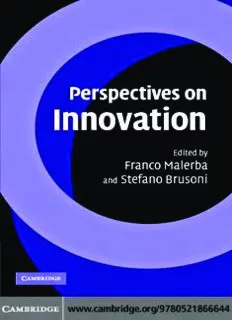
Perspectives on Innovation PDF
Preview Perspectives on Innovation
This page intentionally left blank Innovation has become a major field of study in economics, management, sociology, science and technology, and history. Case studies, empirical models, appreciative analyses and formal theories abound. However, after several decades of study on innovation, and so many different types of contribu- tion,therearestillmanyphenomenaweknowverylittleabout. The debate on innovation still has much to deliver; important questions remain unanswered and many problems require solution. Bringing together many leading figures in the field, this collection aims to address these concerns by offering detailed analyses of topics that are crucial for understanding innovation. In addition, it offers discussions of topics that researchers are just beginning to explore and of topics that continuetodefyoureffortstounderstandandsystematize.This important and wide-ranging collection will be essential reading for academic researchers and graduate students who wish to gain a broad overview of frontier-research in innovation. Franco Malerba is Professor of Industrial Economics and Director of CESPRI at Bocconi University, Milan. Stefano Brusoni is Associate Professor of Applied Economics andDeputyDirectorofCESPRIatBocconiUniversity,Milan. Perspectives on innovation Editors Franco Malerba and Stefano Brusoni CAMBRIDGEUNIVERSITYPRESS Cambridge, New York, Melbourne, Madrid, Cape Town, Singapore, São Paulo Cambridge University Press The Edinburgh Building, Cambridge CB28RU, UK Published in the United States of America by Cambridge University Press, New York www.cambridge.org Information on this title: www.cambridge.org/9780521866644 © Cambridge University Press 2007 This publication is in copyright. Subject to statutory exception and to the provision of relevant collective licensing agreements, no reproduction of any part may take place without the written permission of Cambridge University Press. First published in print format 2006 ISBN-13 978-0-511-29456-3 eBook (EBL) ISBN-10 0-511-29456-5 eBook (EBL) ISBN-13 978-0-521-86664-4 hardback ISBN-10 0-521-86664-2 hardback ISBN-13 978-0-521-68561-0 paperback ISBN-10 0-521-68561-3 paperback Cambridge University Press has no responsibility for the persistence or accuracy of urls for external or third-party internet websites referred to in this publication, and does not guarantee that any content on such websites is, or will remain, accurate or appropriate. Contents List of figure s page viii List of tables x List of contributors xi Prefatory note xv Introduction FRANCO MALERBA AND STEFANO BRUSONI 1 Part 1: Innovation and economic growth 25 1 Understanding economic growth as the central task of economic analysis RICHARD R. NELSON 27 2 Innovation and economic growth theory: a Schumpeterian legacy and agenda BART VERSPAGEN 42 Comments to Chapters 1 and 2 64 JAN FAGERBERG Part 2: The microdynamics of the innovation process 71 3 Schumpeter’s prophecy and individual incentives as a driver of innovation WESLEY M. COHEN AND HENRY SAUERMANN 73 4 Creative destruction in the PC industry TIMOTHY BRESNAHAN 105 Comments to Chapters 3 and 4 ASHISH ARORA 141 v vi Contents Part 3: Innovation and industrial dynamics 151 5 Statistical regularities in the evolution of industries: a guide through some evidence and challenges for the theory GIOVANNI DOSI 153 6 Spin-off entry in high-tech industries: motives and consequences STEVEN KLEPPER AND PETER THOMPSON 187 Comments to Chapters 5 and 6 LUIGI ORSENIGO 219 Part 4: Innovation and institutions 225 7 Schumpeterian innovation in institutions MASAHIKO AOKI 227 8 Innovation and Europe’s academic institutions – second thoughts about embracing the Bayh–Dole regime PAUL A. DAVID 251 Comments to Chapters 7 and 8 BENGT-A˚KE LUNDVALL 279 Part 5: Innovation, firms’ organization, and business strategies 291 9 Bringing selection back into our evolutionary theories of innovation DANIEL A. LEVINTHAL 293 10 From leadership to management: mobilizing knowledge for innovation in strategic alliances YVES L. DOZ, ANDREA CUOMO, AND JULIE WRAZEL 308 Comments to Chapters 9 and 10 SIDNEY G. WINTER 322 Part 6: Innovation and entrepreneurship 331 11 Schumpeterian legacies for entrepreneurship and networks: the social dimensions of entrepreneurial action PIERA MORLACCHI 333 Contents vii 12 Knowledge-based entrepreneurship: the organizational side of technology commercialization ULRICH WITT AND CHRISTIAN ZELLNER 352 Comments to Chapters 11 and 12 MAUREEN MCKELVEY 372 Part 7: Innovation and evolution of the university system 379 13 Academic entrepreneurs and technology transfer: who participates and why? JANET BERCOVITZ AND MARYANN FELDMAN 381 14 Modelling and measuring scientific production: a first estimation for a panel of OECD countries GUSTAVO CRESPI AND ALDO GEUNA 399 Comments to Chapters 13 and 14 W. EDWARD STEINMUELLER 430 Part 8: Innovations and public policy 439 15 Innovation systems, innovation policy and restless capitalism STAN METCALFE 441 16 Intellectual property rights and competition policy PAUL A. GEROSKI 455 17 The policy-shaper’s anxiety at the innovation kick: how far do innovation theories really help in the world of policy? PARASKEVAS CARACOSTAS 464 Index 490 List of figures 3.1 Importance of job characteristics for S&E doctorate recipients 82 3.2 Rankings of importance of job characteristics; engineering and science professionals versus workers (n ¼ 477) 83 4.1 Leading products and firms in widely used PC markets 108 4.2 Positive feedback 115 4.3 Triggers of creative destruction 117 5.1 Empirical densities of log (VA) in different years. 156 i 5.2 Cumulative distribution of US firms by receipts. 157 5.3 Densities of log (S), log (L), and log (Va) in i i i different Italian manufacturing sectors 158 5.4 Growth-rate distributions in different years. Size measured in terms of Value added. Italian aggregate manufacturing 159 5.5 Probability densities and maximum likelihood estimation of firm growth rates g in three different Italian sectors 165 5.6 Distribution of (normalised) gross margins by sectors 168 5.7 Distribution of gross margins growth rates by sectors, Italian data. Each figure displays the maximum likelihood estimates of Subbotin distributions 171 5.8 Distribution of labour productivity by sectors. 175 5.9 Gross margins and (normalized) labour productivity, 1989–1997 178 5.10 Labour productivity and growth rates (measured in terms of sales), 1989–1997 179 5.11 Growth rates and profit margins in different manufacturing sectors 180 viii
Description: